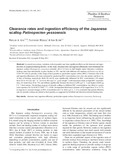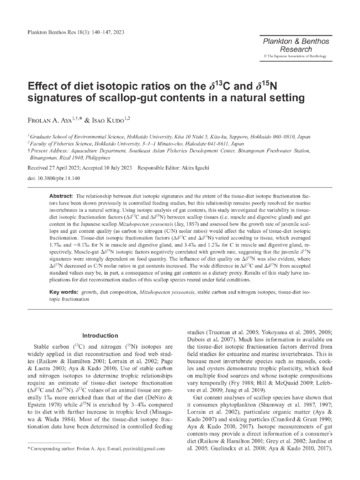Seasonal growth, organ indices and food consumption of the Japanese scallop Patinopecten yessoensis (Jay, 1857) in relation to food availability in Tokoro seabed, Okhotsk Sea, North Japan
- Global styles
- MLA
- Vancouver
- Elsevier - Harvard
- APA
- Help

Download URL
www.jstage.jst.go.jpDate
2022-05-30Page views
544ASFA keyword
AGROVOC keyword
Taxonomic term
Geographic names
Metadata
Perlihat publikasi penuh
Share
Abstract
The coastal waters off Tokoro, Okhotsk Sea have been characterized by a substantial decrease in primary production from spring to summer season which will have repercussions on the maintenance of the Japanese scallop Patinopecten yessoensis (Jay, 1857) culture. This study examined the seasonal changes in scallop growth, condition and organ indices in relation to environmental conditions, and compared the sinking particulate organic carbon (POC) flux as an estimate of food availability to scallop food requirements. Monthly specimens were obtained in July 2005, and from May 2006 to December 2008 off Tokoro, Okhotsk Sea. Growth parameters derived from the modified von Bertalanffy growth function of 885 scallop individuals were the mean asymptotic shell height H∞=126.51 mm, Brody growth coefficient K=0.081 year−1, and t0=6.19 year. Condition (CI) and gonadosomatic indices (GSI) increased in April and May, decreased from June to September, but increased again from October until May. The adductor muscle index (AMI) increased from June to October, but declined from November until May when CI and GSI began to increase. Primary production (PP) and chlorophyll a biomass decreased from spring (25.75–29.74 µg C L−1 h−1 and 1.74–5.37 µg L−1) to autumn (0.90–10.83 µg C L−1 h−1 and 0.29–0.75 µg L−1) concurrent with decreasing CI and GSI, but no deleterious effect on AMI was evident during these periods. The sinking POC flux (25–68 mg C m−2 day−1) was low during summer when gonad activity was also low, but started to increase in autumn when gonad activity started to peak. Although a deficit in food availability (lower sinking POC fluxes than scallop food consumption) was observed during summer, the potential advection of organic matter from offshore to nearshore region may have provided additional source of food to bottom-cultured scallops, contributing in part to the increase in shell growth and somatic tissues.
Keywords
Condition indices Food consumption Growth Japanese scallops Sinking particulate organic carbon fluxSuggested Citation
Aya, F., & Kudo, I. (2022). Seasonal growth, organ indices and food consumption of the Japanese scallop Patinopecten yessoensis (Jay, 1857) in relation to food availability in Tokoro seabed, Okhotsk Sea, North Japan. Plankton and Benthos Research , 17(2), 156-164. https://doi.org/10.3800/pbr.17.156
Type
ArticleISSN
1880-8247; 1882-627XKoleksi
- Journal Articles [1258]
Related items
Showing items related by title, author, creator and subject.
-
Clearance rates and ingestion efficiency of the Japanese scallop Patinopecten yessoensis
In coastal ecosystems, variations in food quantity may have significant effects on the clearance and ingestion rates of suspension-feeding bivalves. In this study, clearance rates and ingestion efficiencies were determined ... -
Nitrogen stable isotopes reveal age-dependent dietary shift in the Japanese scallop Mizuhopecten yessoensis
Ontogenetic niche shifts in diet are a consequence of changes in body size or resource partitioning between age classes. To better resolve the feeding patterns of the Japanese scallop Mizuhopecten yessoensis, we examined ... -
Effect of diet isotopic ratios on the \(\mathsf{\delta^{13}C}\) and \(\mathsf{\delta^{15}N}\) signatures of scallop-gut contents in a natural setting
The relationship between diet isotopic signatures and the extent of the tissue-diet isotope fractionation factors have been shown previously in controlled feeding studies, but this relationship remains poorly resolved for ...







